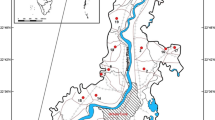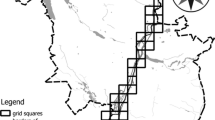Abstract
Urena lobata, a pan-African weed has been described as a noxious invader which has spread across several countries in the world. Its ability to grow in a variety of habitats has enabled its success as an invader. However, there is a paucity of data on its invasion ecology in relation to land use in invaded ranges of Nigeria. In this study, the cover of U. lobata along roadsides and in relation to the land use of adjacent lands in five sites across major cities in Nasarawa State, Nigeria was assessed. Its abundance and impacts on native plant diversity and species richness were investigated. U. lobata was discovered in 74.6% of the sampled sites along the roadsides in Nasarawa State. Land use of the adjacent land had a significant effect on the roadside cover of U. lobata in the study area. The density of U. lobata ranged from 9533 to 17,166 mature individual ha−1 across the State. This plant exhibited a negative impact on native plant diversity by reducing the species richness and diversity indices of the invaded sites. From this study, it is evident that land use plays a significant role in the spread and establishment of U. lobata across the guinea savanna vegetation of Nigeria.



Similar content being viewed by others
Data availability
The datasets generated during and/or analysed during the current study are available from the corresponding author upon reasonable request.
References
Akomolafe G, Nkemdy A (2020) Analysis of heavy metals in soils and plants along roadsides in Lafia, Nigeria. Trans Sci Technol 7(3):101–107
Akomolafe GF, David OA, Nkemdy AJ (2019) Comparative anatomical studies of responses of some roadside plants to highway automobile exhausts. J Res For Wildl Environ 11(3):246–255
Akomolafe GF, Rahmad Z (2020) Relating the land-use changes to the invasion of Pneumatopteris afra in Nigeria using remote sensing. Pertanika J Sci Technol. https://doi.org/10.47836/pjst.28.4.12
Akomolafe GF, Rahmad Z B (2022) Colonization of Pneumatopteris afra (Christ) Holttum and its impact on some resident wetland communities in Nigeria. Acta Ecol Sin 42(2):43–48
Anibaba QA, Yilangai RM, Wala ZW, Saha S (2021) Land-use is more important predictor of native abundance and diversity than invasive tithonia diversifolia-evidence from a tropical Savanna
Anning AK, Yeboah-Gyan (2007) Diversity and distribution of invasive weeds in Ashanti Region, Ghana. Afri J Ecol 45(3):355–360. https://doi.org/10.1111/j.1365-2028.2007.00719.x
Ansong M, Pergl J, Randall R, Pyšek P, Essl F, Hejda M, Kleunen MV (2019) Naturalized and invasive alien flora of Ghana. Biol Invas 21:669–683. https://doi.org/10.1007/s10530-018-1860-7
Arianoutsou M, Delipetrou P, Vila M, Dimitrakopoulos PG, Celesti-Grapow L, Wardell-Johnson G, Rundel PW (2013) Comparative patterns of plant invasions in the Mediterranean biome. PLoS One 8(11):e79174
Austin DF (1999) Caesar’s weed (Urena lobata): an invasive exotic or a Florida native? Wildl Weeds 3(1):13–16
Bansal S, Sheley RL (2016) Annual grass invasion in sagebrush steppe: the relative importance of climate, soil properties and biotic interactions. Oecologia 181:543–557
Barlow J, França F, Gardner TA, Hicks CC, Lennox GD, Berenguer E, Castello L, Economo EP, Ferreira J, Guénard B (2018) The future of hyperdiverse tropical ecosystems. Nature 559(7715):517–526
Bart D, Davenport T, Carpenter Q (2015) Stress and land-use legacies alter the relationship between invasive-and native-plant richness. J Veg Sci 26(1):80–88
Bellard C, Jeschke JM (2016) A spatial mismatch between invader impacts and research publications. Conserv Biol 30(1):230–232
Burgess N, Hales JA, Underwood E, Dinerstein E, Olson D, Itoua I, Newman K (2004) Terrestrial ecoregions of Africa and Madagascar: a conservation assessment. Island Press, Washington
Calinger K, Calhoon E, Chang H C, Whitacre J, Wenzel J, Comita L, Queenborough S (2015) Historic mining and agriculture as indicators of occurrence and abundance of widespread invasive plant species. PloS one 10(6):e0128161
Chandra SK (2012) Invasive alien plants of Indian Himalayan region—diversity and implication. Amer J Plant Sci 3:177–184
Chao A, Ma KH, Hsieh TC (2016) iNEXT (iNterpolation and EXTrapolation) online: Software for interpolation and extrapolation of species diversity. Retrieved May 25, 2022, from http://chao.stat.nthu.edu.tw/wordpress/software_download
Csecserits A, Botta-Dukát Z, Kröel-Dulay G, Lhotsky B, Ónodi G, Rédei T, Szitár K, Halassy M (2016) Tree plantations are hot-spots of plant invasion in a landscape with heterogeneous land-use. Agri Ecosys Environ 226:88–98
Dimitrakopoulos PG, Koukoulas S, Galanidis A, Delipetrou P, Gounaridis D, Touloumi K, Arianoutsou M (2017) Factors shaping alien plant species richness spatial patterns across Natura 2000 Special Areas of Conservation of Greece. Sci Total Environ 601:461–468
Faulkner KT, Burness A, Byrne MJ, Kumschick S, Peters K, Robertson MP, Williams VL (2020) South Africa’s pathways of introduction and dispersal and how they have changed over time. In Biological Invasions in South Africa (pp. 313–354). Cham, Switzerland: Springer
Fensham R J, Donald S, Dwyer J M (2013) Propagule pressure, not fire or cattle grazing, promotes invasion of buffel grass Cenchrus ciliaris. J Appl Ecol 50(1):138–146
Florida Exotic Pest Plant Council (2011) Florida EPPC's 2011 Invasive Plant Species List. Retrieved May 28, 2022, from http://www.fleppc.org/list/11list.html
Francis JK (2000) Wildland shrubs of the United States and its territories: thamnic descriptions. General Technical Report - International Institute of Tropical Forestry, IITF-WB-1
Francis JK (2004) Wildland shrubs of the United States and its territories: thamnic descriptions, Volume 1. Gen. Tech. Rep. IITF-GTR-26. San Juan, PR: US Department of Agriculture, Forest Service, International Institute of Tropical Forestry; Fort Collins, CO: US Department of Agriculture, Forest Service, Rocky Mountain Research Station. 830 p., 26
Freestone AL, Ruiz GM, Torchin ME (2013) Stronger biotic resistance in tropics relative to temperate zone: effects of predation on marine invasion dynamics. Ecology 94(6):1370–1377
González-Moreno P, Diez JM, Ibáñez I, Font X, Vilà M (2014) Plant invasions are context-dependent: multiscale effects of climate, human activity and habitat. Diver Distri 20(6):720–731
Harris RF (1981) Effect of water potential on microbial growth and activity. Water Pot Rel Soil Microb 9:23–95
Hammer Ø, Harper DA, Ryan PD (2001) PAST: paleontological statistics software package for education and data analysis. Palaeon Elect 4(1):9
Kuhman TR, Pearson SM, Turner M G (2011) Agricultural landuse history increases non-native plant invasion in a southern Appalachian forest a century after abandonment. Canad J For Res 41(5):920–929
Langeland KA, Cherry HM, McCormick CM, Craddock BKA (2008) identification and biology of non-native plants in florida’s natural areas. University of Florida IFAS Extension, Gainesville
Lövei GL, Lewinsohn TM, Dirzo R, Elhassan EF, Ezcurra E, Freire CA, Gui FR, Halley JM, Tibazarwa JM, Jiang MX (2012) Megadiverse developing countries face huge risks from invasives. Trends Ecol Evol 27(1):2–3
Margalef R (1969) Diversity and stability: a practical proposal and a model of interdependence. Brookhaven Symp BioI 22:25–37
Morales-Romero D, Lopez-Garcia H, Martinez-Rodriguez J, Molina-Freaner F (2019) Documenting a plant invasion: the influence of land use on buffelgrass invasion along roadsides in Sonora, Mexico. J Arid Environ 164:53–59
Nuñez MA, Pauchard A (2010) Biological invasions in developing and developed countries: does one model fit all? Biol Invas 12(4):707–714
Okach DO, Amuka O (2015) Plant species diversity along road reserve in Kisumu County Kenya. Ecologia 5(1):8–21. https://doi.org/10.3923/ecologia.2015.8.21
Peet RK (1974) The measurement of species diversity. Ann Rev Ecol Syst 5(1):285–307
PIER (2012) Pacific Islands Ecosystems at Risk. Honolulu, USA: HEAR, University of Hawaii. Retrieved June 10, 2022 from http://www.hear.org/pier/index.html
Potgieter LJ, Douwes E, Gaertner M, Measey J, Paap T, Richardson DM (2020) Biological invasions in South Africa’s urban ecosystems: patterns, processes, impacts, and management. Biological invasions in South Africa. Springer, Cham, pp 275–309
Pyšek P, Richardson DM, Pergl J, Jarošík V, Sixtová Z, Weber E (2008) Geographical and taxonomic biases in invasion ecology. Trends Ecol Evol 23(5):237–244. https://doi.org/10.1016/j.tree.2008.02.002
Pyšek P, Jarošík V, Hulme PE, Kühn I, Wild J, Arianoutsou M, Winter M (2010) Disentangling the role of environmental and human pressures on biological invasions across Europe. Proc Nat Acad Sci 107(27):12157–12162
Pyšek P, Jarošík V, Hulme P E, Pergl J, Hejda M, Schaffner U, Vilà M (2012) A global assessment of invasive plant impacts on resident species, communities and ecosystems: the interaction of impact measures, invading species' traits and environment. Glob Chang Biol 18(5):1725–1737
Rahmad ZB, Akomolafe GF (2018) Distribution, diversity and abundance of ferns in a tropical university campus. Pert J Trop Agri Sci 41(4):1875–1887
Randall RP (2012) A global compendium of weeds., Perth, Australia: Department of Agriculture and Food Western Australia. p 1124
Rembold K, Mangopo H, Tjitrosoedirdjo SS, Kreft H (2017) Plant diversity, forest dependency, and alien plant invasions in tropical agricultural landscapes. Biol Conserv 213:234–242
Rojas-Sandoval J, Meléndez-Ackerman E J, Anglés-Alcázar D (2016) Assessing the impact of grass invasion on the population dynamics of a threatened Caribbean dry forest cactus. Biol Conserv 196:156–164
Sax DF (2001) Latitudinal gradients and geographic ranges of exotic species: implications for biogeography. J Biogeo 28(1):139–150
Shannon CE, Weaver W (1949) The mathematical theory of communication. University of Illinois Press, Urbana
Simberloff D, Martin J L, Genovesi P, Maris V, Wardle D A, Aronson J, Vilà M (2013) Impacts of biological invasions: what's what and the way forward. Trends Ecol Evol 28(1):58–66
Simpson EH (1949) Measurement of diveristy. Nature 163:688
Strum SC, Stirling G, Mutunga SK (2015) The perfect storm: Land use change promotes Opuntia stricta's invasion of pastoral rangelands in Kenya. J Arid Environ 118:37–47
Vila M, Ibáñez I (2011) Plant invasions in the landscape. Landsc Ecol 26(4):461–472
van Wilgen B, Measey J, Richardson D, Wilson J, Zengeya T (2020) Biological invasions in South Africa: an overview. In: van Wilgen BW, Measey J, Richardson DM, Wilson JR, Zengeya TA (eds) Biological Invasions in South Africa, invading nature - Springer series in invasion ecology. Springer, Berlin, pp 3–31
Acknowledgements
We would like to acknowledge all who assisted us during the field sampling. Also, special thanks to the Ministry of Higher Education, Malaysia for the financial aid through the Fundamental Research Grant Scheme.
Funding
This project was funded by the Ministry of Higher Education Malaysia for the Fundamental Research Grant Scheme (FRGS) with Project Code: FRGS/1/2021/WAB11/USM/02/3.
Author information
Authors and Affiliations
Contributions
GFA conceived of the research idea, collected data and performed statistical analyses; RR supervised the research and edited the paper. All authors discussed the results and commented on the manuscript.
Corresponding author
Ethics declarations
Conflict of interest
The authors have no relevant financial or non-financial interests to disclose.
Additional information
Publisher's Note
Springer Nature remains neutral with regard to jurisdictional claims in published maps and institutional affiliations.
Rights and permissions
Springer Nature or its licensor (e.g. a society or other partner) holds exclusive rights to this article under a publishing agreement with the author(s) or other rightsholder(s); author self-archiving of the accepted manuscript version of this article is solely governed by the terms of such publishing agreement and applicable law.
About this article
Cite this article
Akomolafe, G.F., Rosazlina, R. Evidence of invasion: land use influences the invasion of Urena lobata in the Guinea Savanna ecosystems of Nigeria. Biol Invasions 25, 2175–2184 (2023). https://doi.org/10.1007/s10530-023-03030-6
Received:
Accepted:
Published:
Issue Date:
DOI: https://doi.org/10.1007/s10530-023-03030-6




